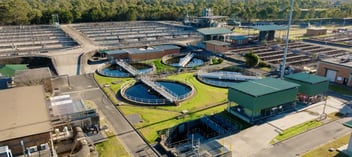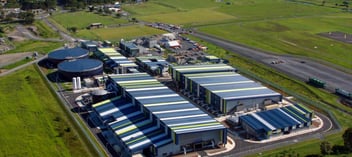The solutions that could help safeguard against water scarcity
The general usage of water is far more than the average person realises, with global water availability issues now ramping up the pressure for water efficiency on a local level. Faced with issues such as the dual challenge of climate change and rapidly growing populations, securing water supply for the long-term has become an imperative that’s ever more pressing, writes Sylvia Pennington.
Technology-based treatment and storage solutions may provide part of the solution to water availability but determining the optimum combination is no simple matter, nor is harnessing the political landscape and community to see them implemented.
With a wide-spread view that new dams are off the agenda around the country, authorities have little choice but to turn their focus to desalination, recycling and water reduction initiatives, according to Dr Ian Wright, Senior Lecturer in Natural Science at Western Sydney University.
“We store massive amounts of water for domestic supply, in comparison to other parts of the world because our [water] flow is so variable … more than any other country,” Wright said.
“So, the trouble is, we’ve dammed all the rivers we can without a community outcry.”
With desalination becoming a more acceptable solution, plants are now in place in all capital cities, bar Canberra and Hobart. For example, Perth’s two desalination plants can supply about half the city’s
drinking supplies – around 150GL a year.
“I think there’s more [desalination] on the cards, particularly for the smaller centres,” Wright said.
Recycling schemes such as Sydney Water’s Rouse Hill Water Recycling Plant project may also form a greater part of the puzzle in the future.
Established in 2001, the plant treats and purifies wastewater from surrounding suburbs and supplies 27GL of recycled water a year to 32,000 properties in Sydney’s north west. Households in the catchment area use 40% less drinking water than other customers in greater Sydney.
Investment in similar schemes could lead to a significant reduction in demand for potable water nationwide but the high costs associated with treatment and supply make it an uneconomic proposition for utilities, Wright observed.
Balancing approaches
So what should be done to ensure Australia doesn’t reach levels of water scarcity?
A greater focus on demand reduction and decentralised solutions would make for a more balanced and efficient ecosystem and allow utilities to defer spending on large-scale infrastructure, AWA Water Efficiency Network member and Kingspan Technical and Sustainability Manager Michael Smit suggested.
“When you mix a decentralised source, like rainwater harvesting and water-efficient appliances with a central source, you’re getting that combination of very efficient local measures backed up with the security of a big system,” Smit said.
“You get a solution that is much more efficient than either of those systems on their own. It’s not sufficient to just have rainwater tanks because you need enormous tanks at every house to provide enough water, but it’s also not efficient to just have a central supply. The combination is what gives you a better overall solution.”
Details matter
A rainwater tank can reduce drinking water use by around 40%, or 96,000L a year, according to Sydney Water. And just over 2.3 million households used tank water in 2013, according to the Australian Bureau of Statistics.
A greater reliance on locally stored water can also mean reduced or deferred spending on centralised solutions, Smit pointed out.
“You don’t need to switch on a desalination plant, you don’t need to build another desalination plant and you don’t need to expand the size of your system to include another dam or huge treatment plants as the city gets bigger because you’re taking the heat out of the system by increasing your savings.
“And a permanent reduction in demand is exactly the same as an increase in supply.”
Meanwhile, disruptive new technologies are promising and delivering new options for conserving and increasing water supply. They include the Swedish developed Watreco Vortex Process Technology, a whirlpool-style method of processing water which alters its properties, making it more efficient across a variety of commercial applications.
Closer to home, CSIRO scientists hit headlines in early 2018 with a new graphene filter coating that makes the process of water purification simpler and faster. The introduction of monitoring technology to provide consumers with more immediate feedback could also be an effective way to further cut household usage, according to Wright.
“It’s worked well in the energy sector. Having that monitoring technology on an individual basis shows people what they’re doing at ground level,” Wright pointed out.
“You look at your water meter and it’s a lot harder [to derive value from feedback], so not many people monitor it. If people got that feedback, they would. I can imagine people with a smartphone or a watch showing how much water [they’ve] used and getting proud about getting close to 150L a day.”
Slow change
Public awareness of the need to be water smart has risen significantly in recent times, according to AWA Water Efficiency Network member and environmental consultant Reid Butler.
“Every person has to understand in their daily life how to use water and I know that’s becoming part of the norm,” Butler said.
But, in the absence of a pressing threat to supply, more rapid introduction of new technologies is unlikely to occur, given the water sector’s deep-seated conservatism, Northern Territory Power and Water Corporation Living Water Smart program manager Jethro Laidlaw said.
“Water’s such a critical thing for everybody – we have to have multiple barriers to risk, so to take on a new technology increases the risk,” he said.
“There’s nothing like a good crisis for people to find the money and be willing to take on a bit more risk.”
While dams and bores are the backbone of the water system in the NT and across Australia, the future will see the country relying on a broader medley of solutions, Laidlaw said.
“We have to look to demand management, we have to look to new technologies, smart metering, smart irrigation controllers and, further down the track, it’ll be water recycling and water sensitive urban development – but, certainly in the Territory, those [last] two things are quite a long way down the track.”
WA keeping water efficiency on the agenda
Consistent decline in rainfall over the past 40 years has been the spur for WA Water Corporation to develop a long-term strategy to ensure water supply for the two million individuals it services in Western Australia.
Since the 1970s, rainfall in the south west of the state has reduced by around 19% and stream flows to dams have declined even more dramatically. Before 1975, Perth’s dams received about 394GL of stream flow annually, but significant drying of catchment areas has seen the volume plummet to 11.4GL in 2015.
Water Corp then delivered its 50-year Water Forever plan in 2009 and a 10-year plan in 2011, calling for new water sources development, usage reduction and increased recycling.
Two desalination plants added almost 150GL to the region’s supply in 2016-17, while a new Groundwater Replenishment Scheme, in which secondary treated wastewater is treated to produce recycled water, could add 28GL to Perth aquifers when complete.
Educating the community has been a crucial part of the strategy too.
Water Corp spokeswoman Clare Lugar said most people in Perth understand the need to invest in new water sources that don’t rely on rainfall. Lugar added that water-reduction initiatives have also been well received.
“Reducing water use is a cost-effective and environmentally responsible option to reduce demand on water supplies and potentially defer major capital expenditure,” Lugar said.
“The Perth community is well aware that it lives in one of the driest cities in the world. Saving water is the right thing to do – so even though Perth is not experiencing a water crisis, customers will continue to find ways to save, like they’ve done in the past, successfully.”
First published as 'Valuing what matters' in Current magazine May 2018.



